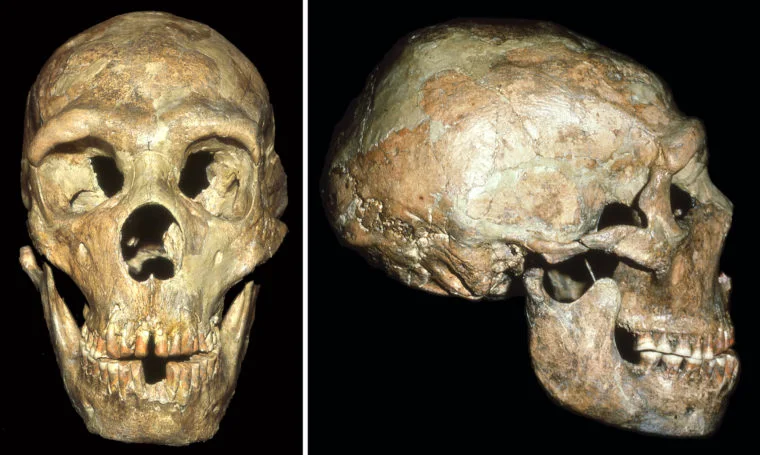 |
| The skull of a Neandertal known as Shanidar 1 show signs of a blow to the head received at an early age. Photo: Erik Trinkaus |
Here we have lovely evidence that altruism and compassion are not uniquely modern human characteristics, as creationists would have us believe.
A 50,000 year-old Neanderthal, unearthed in 1957 during excavations at Shanidar Cave in Iraqi Kurdistan and know to science has Shanidar 1, shows evidence of old injuries and medical conditions that would have made independent existence in the Pleistocene impossible.
A new examination of the skeleton by Erik Trinkaus of Washington University in St. Louis and Sébastien Villotte of the French National Centre for Scientific Research, shows that the male in his 40s (believed to be elderly for a Neanderthal) must have received considerable support and care following his injuries which would have made hunting and foraging difficult or impossible. He is unlikely to have avoided falling prey to the many predators in the Pleistocene.
 |
| Two views of the ear canal of the Neandertal fossil Shanidar 1 show substantial deformities that would likely have caused profound deafness. Photos: Erik Trinkaus |
Abstract
The Late Pleistocene Shanidar 1 older adult male Neandertal is known for the crushing fracture of his left orbit with a probable reduction in vision, the loss of his right forearm and hand, and evidence of an abnormal gait, as well as probable diffuse idiopathic skeletal hyperostosis. He also exhibits advanced external auditory exostoses in his left auditory meatus and larger ones with complete bridging across the porus in the right meatus (both Grade 3). These growths indicate at least unilateral conductive hearing (CHL) loss, a serious sensory deprivation for a Pleistocene hunter-gatherer. This condition joins the meatal atresia of the Middle Pleistocene Atapuerca-SH Cr.4 in providing evidence of survival with conductive hearing loss (and hence serious sensory deprivation) among these Pleistocene humans. The presence of CHL in these fossils thereby reinforces the paleobiological and archeological evidence for supporting social matrices among these Pleistocene foraging peoples.
Trinkaus E, Villotte S (2017)
External auditory exostoses and hearing loss in the Shanidar 1 Neandertal.
PLoS ONE12(10): e0186684. https://doi.org/10.1371/journal.pone.0186684
Copyright © 2017 Trinkaus, Villotte
Published open access
Reprinted under the terms of a Creative Commons Attribution 4.0 International License (CC BY 4.0)
This lends support to the idea that there was a supporting social matrix in Neanderthal society suggested by the finding of a Neanderthal from the Middle Pleistocene with a similar hearing impairment, at the Atapuerca site in Spain.
More than his loss of a forearm, bad limp and other injuries, his deafness would have made him easy prey for the ubiquitous carnivores in his environment and dependent on other members of his social group for survival.
The fact of a supportive social system where the disabled and elderly were cared for, is not really surprising in an intelligent species in which social cohesion was probably essential for the hunter-gatherer life-style in the Pleistocene but it gives the lie to creationist assertions that the modern human qualities of altruism and compassion somehow set us apart from the 'lower' animals and are evidence of a special creation and justify our assumed role of guardians of the Earth, as bestowed on us by a creator god.Erik Trinkaus, co-author
Professor of Anthropology in Arts & Sciences
Washington University in St. Louis.
Professor of Anthropology in Arts & Sciences
Washington University in St. Louis.
In fact, the problem runs even deeper for creationists because the fact that this altruistic, humanitarian culture was present in Neanderthals is strngly suggestive that it was also present in their common ancestor with us. Anthropologists are currently divided on the precise relationship between Homo sapiens and H. neaderthalensis but no-one believes they were our direct ancestors. The most likely relationship seems to be that both species evolved from H. erectus; Neanderthals in Eurasia and modern humans in Africa. Some believe that Neanderthals may have evolved from H. erectus via H. heidelbergensis.
The closest relationship between moderns and Neanderthals is that of cousins but we may be only second cousins. The details are important only in as much as they suggest these cultural attributes may well have arisen in our remote African ancestors and so are by no means a unique characteristic of modern humans.
If our remote African ancestors were altruistic, then it's hard to argue that altruism isn't an evolved feature.
Strangely, creationists always seem to avoid noticing how these research finding invariably and incidentally support the Theory of Evolution and never support creationism.
'via Blog this'

No comments:
Post a Comment
Obscene, threatening or obnoxious messages, preaching, abuse and spam will be removed, as will anything by known Internet trolls and stalkers, by known sock-puppet accounts and anything not connected with the post,
A claim made without evidence can be dismissed without evidence. Remember: your opinion is not an established fact unless corroborated.